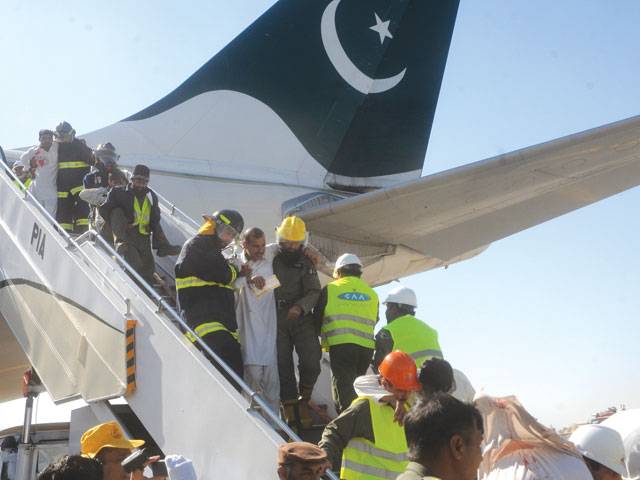ISLAMABAD - In the wake of prevailing terror threats, the Civil Aviation Authority (CAA) conducted a fire-fighting exercise here on Wednesday that has been declared as mandatory under the United Nations rules, in an attempt to augment its rescue and fire fighting service (RFFS) capability.
Named Aircon 14 and held at Benazir Bhutto International Airport (BBIA), the biannual drill would also be conducted at the other major international airports of the country including those in Karachi, Lahore, Quetta and Peshawar in the coming days. It was last held in December 2011. The related rules of the UN's International Civil Aviation Organisation (ICAO) bind all the ICAO member states to conduct the fire fighting exercise in line with keeping up with the world aviation body's standards to follow foolproof safety practices at the airports and aircraft.
"Airports across the globe are prone to untoward incidents and emergency-like situations due to ever increasing air traffic. This demands adequate responsive measures that have been adopted everywhere in the world, surely but not completely," CAA's Airport Manager (APM) at BIIA Ayaz Jadoon told The Nation on the sidelines of the exercise demonstration ceremony held at the airport. "Under the existing situation, it becomes essential for us to introduce and practice foolproof safety measures," he said adding that the exercise's conduct was part of the same policy.
Earlier, a mock drill of Aircon 14 was demonstrated before a group of journalists and senior government functionaries at the airport's runway using an Airbus (A-310) plane of Pakistan International Airlines (PIA).
Tahir Sikandar, CAA Deputy Airport Manager at BBIA, said the scenario of the simulated drill involved the aircraft's crash landing resulting in breaking its wings and catching fire. Immediately after the mock incident, fire-fighting units rushed to the scene and extinguished fire instantly. "The response time was three minutes. The outcome of the simulated accident was five passengers dead, eight seriously injured, 12 given first aid, 15 passengers slightly injured and the remaining 90 evacuated safely," the officer informed. The rescue teams evacuated the mock passengers from the plane and shifted them to the twin cities through ambulances and helicopter.
According to CAA, Pakistan, being the signatory of ICAO conventions is bound to implement the related standards and recommended practices to ensure smooth airport operations. The ICAO's Annex 14 on Aerodrome Design and Operations contains the Standards and Recommended Practices (SARPs) adopted by the world body's Council, which binds all the 191 member states of the ICAO to provide rescue and fire fighting equipment and services at every airport. The ICAO reviews their SARPs through their Rescue and Fire Fighting Working Group (RFFWG).
Being part of the ICAO's Airport Services Manual, the Document 9137-AN/898 on Rescue and Fire Fighting provides related guidelines in this regard. Its relevant sections state, the principal objective of a rescue and fire fighting service is to save lives in the event of an aircraft accident or incident. This contingency must assume at all times the possibility of and need for extinguishing a fire which may: a) exist at the time an aircraft is landing, taking off, taxiing, parked etc or b) occur immediately following an aircraft accident or incident; or c) occur at any time during rescue operations.
The Section 7 (81) of Pakistan's Civil Aviation Rules 1994 provides, a fire fighting and rescue service established and maintained (by the CAA) is responsible for all operations in connection with: (a) the rescuing of persons and property from an aircraft that has crashed, has caught fire or has otherwise been involved in an accident on, or in the vicinity of, an aerodrome; and (b) the control and extinguishing of, and the protection of persons and property threatened by: (i) a fire at an aerodrome, whether in an aircraft or elsewhere on the aerodrome; or (ii) a fire in the vicinity of an aerodrome, being a fire that is in, or that originated in an aircraft.
The CAA said, the purpose of Wednesday exercise was to test its Crises and Emergency Response Plan (CERP), improve the deficiencies and review this plan accordingly, to evaluate the response of RFFs and medical and security agencies, performance of airlines and airport functionaries, familiarisation of participating agencies with their role and airport environment and establish rapport among participating agencies.
Wednesday, December 04, 2024
CAA conducts fire-fighting drill in wake of terror threats

Caption: CAA conducts fire-fighting drill in wake of terror threats
11:03 AM | December 03, 2024
PRCS marks Int’l Day of Persons with Disabilities
December 04, 2024
CM Bugti emphasises for ensuring transparency in development programme
December 04, 2024
Sukkur Barrage to remain closed from Jan 6-20
December 04, 2024
-
Three new polio cases reported in Pakistan, total rises to 59 in 2024
-
Three new polio cases reported in Pakistan, total rises to 59 in 2024
-
Nationwide internet disruptions cause major challenges for users
-
Gallup survey: 47pc of Pakistanis never used trains
-
Digital nomadism redefines work and travel across the globe
-
Lahore tops global pollution rankings as smog worsens, AQI reaches hazardous levels
Crisis in Korea
December 04, 2024
COAS’ Resolve
December 04, 2024
Crippling Social Media
December 04, 2024
Biden’s Last Gasp
December 03, 2024
Slashing Inflation
December 03, 2024
Major Environmental Problems in Balochistan
December 04, 2024
Contemporary Discipline Issues in Academics
December 04, 2024
Unprivileged Area
December 04, 2024
Beware of Product Warranties!
December 04, 2024
Law and Order
December 04, 2024
ePaper - Nawaiwaqt
Nawaiwaqt Group | Copyright © 2024





